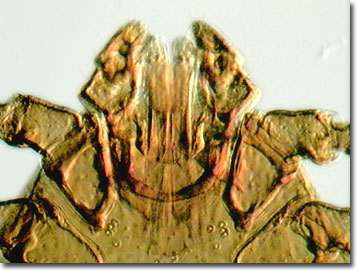Oblique Digital Image Gallery
Bush Tick (Haemaphysalis longicornis)
The scrub or bush tick, Haemaphysalis longicornis, is a parasitic tick commonly found on domestic animals in Australia and New Zealand. Also known as the New Zealand cattle tick, this ectoparasite of dogs, cattle, donkeys, and horses, was first introduced "Down Under" from northern Japan around 1900, but is now found throughout the Western Pacific Rim and some of the Pacific Islands including Hawaii and Fiji. These ticks are also known to infest deer, sheep, goats, pigs, and humans, as they spread throughout the region.

As a livestock pest, particularly in coastal regions, the bush tick causes significant economic harm, particularly during the spring and summer months, when their numbers explode, damaging animal hides and creating problems that lower production. Similar to many species in the genus Ioxdes (paralysis ticks), bush ticks lack eyes, but feature festoons (grooves similar in appearance to the ventral edge scutes of turtles) and a posterior anal groove. As with other members of the class Arachnoida (spiders, mites, and ticks), the bush tick features eight legs, an oval body, and a tiny head. Larval H. longicornis spends it parasitic developmental stages on one host for approximately 21 days. As an adult, the female feeds slowly for about a week, engorging with blood and mating, and then drops into the pasture. There she lays up to 3,000 eggs and perishes. The larvae hatch as free-living ticks in the pasture during a two-month period in the summer, or up to six months over the winter, depending on whether a suitable host is located. Males on the other hand, do not fill with blood, but rather wander over the host for about two months, mating with females.
Contributing Authors
Cynthia D. Kelly, Thomas J. Fellers and Michael W. Davidson - National High Magnetic Field Laboratory, 1800 East Paul Dirac Dr., The Florida State University, Tallahassee, Florida, 32310.
BACK TO THE OBLIQUE IMAGE GALLERY
BACK TO THE DIGITAL IMAGE GALLERIES
Questions or comments? Send us an email.
© 1995-2025 by Michael W. Davidson and The Florida State University. All Rights Reserved. No images, graphics, software, scripts, or applets may be reproduced or used in any manner without permission from the copyright holders. Use of this website means you agree to all of the Legal Terms and Conditions set forth by the owners.
This website is maintained by our
Graphics & Web Programming Team
in collaboration with Optical Microscopy at the
National High Magnetic Field Laboratory.
Last Modification Friday, Nov 13, 2015 at 01:19 PM
Access Count Since September 17, 2002: 14279
Visit the website of our partner in introductory microscopy education:
|
|
